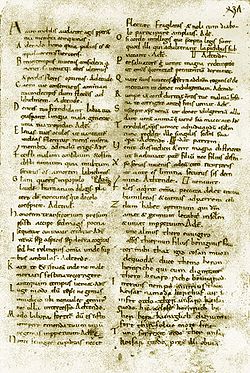
Back Latín medieval AN لاتينية العصور الوسطى Arabic Llatín medieval AST Llatí medieval Catalan Middelalderlatin Danish Mittellatein German Medieval Latin English Mezepoka latino Esperanto Latín medieval Spanish لاتین قرون وسطی Persian
| Medieval Latin | |
|---|---|
 Carmina Cantabrigiensia, Medieval Latin manuscript | |
| Native to | Many small states |
| Region | Most of Europe |
| Era | Developed from Late Latin between 4th and 10th centuries; replaced by Renaissance Latin from the 14th century |
Indo-European
| |
Early forms | |
| Latin alphabet | |
| Official status | |
Official language in | De facto in most Christian states during the Middle Ages |
| Language codes | |
| ISO 639-3 | – |
lat-med | |
| Glottolog | None |
 Europe, 1000 AD | |
Medieval Latin was the form of Latin that was used in the Middle Ages. It was used mostly by scholars and as the liturgical language of the medieval Roman Catholic Church, but it was used also as a language of science, literature and administration.
Despite the clerical origin of many of its authors, Medieval Latin should not be confused with Ecclesiastical Latin. There is no consensus on exactly when Late Latin ends, and Medieval Latin begins. Some scholars have their surveys of it begin with the rise of early Christian Latin in the mid-4th century, but others have around the year 500.[1]

- ↑ Jan M.Ziolkowsky, "Towards a History of Medieval Latin Literature", in: F. A. C. Mantello and A. G. Rigg (eds.), Medieval Latin: An Introduction and Bibliographical Guide (Washington, D.C., 1996), pp. 505-536 (pp. 510-511)